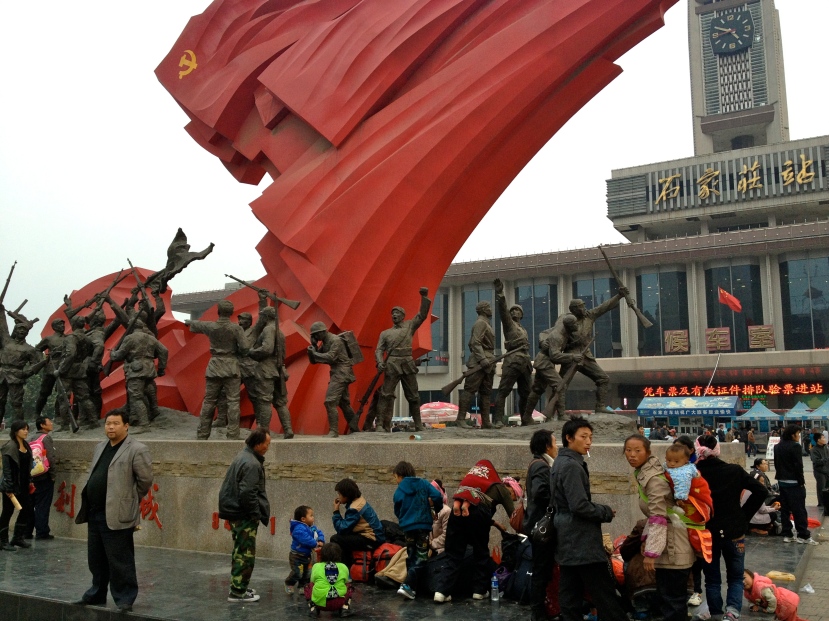
Revolutionary sculpture at Shijiazhuang train station. In front is a group of freshly arrived migrants from the countryside looking for work (photo by Isham Cook, Oct. 2012).
“Qiu Baoxing [vice-minister of the Ministry of Housing and Urban-Rural Development] said during an industry forum that Chinese buildings can only stand for between 25 and 30 years. In contrast, the average life expectancy of a building in Britain is 132 years and they last around 74 years in the United States.” (Qian Yanfeng, “‘Most homes’ to be demolished in 20 years,” China Daily, August 7, 2010)
HOW TO HAVE FUN…
Let’s take a tour of a third-tier Chinese city, Shijiazhuang, “Stone House Village” (pop. ten million), capital of Hebei, the province that surrounds Beijing like the letter C. I choose this city after being invited there by a young woman I befriended recently in Beijing. The circumstances of our meeting were peculiar and quickly endeared me to her. I was making my way down an unfamiliar lane in the popular Nanluoguxiang bar area to kill time before an appointment with a friend, and stopped in front of a reggae club. Vaguely aware of a woman standing nearby, I walked inside for a drink. A moment later she came in as well and with a shy smile asked if she could join me.
Xiaozhen was 21, a college senior in management from Shijiazhuang, in Beijing to interview for prospective work in TV commercial acting. She had never been inside a bar before. While all Chinese cities nowadays have bars and nothing is stopping them from entering, few single women dare do so unless in the company of a man or group of friends. So she landed on me as an older gentlemanly type who could justify her presence. She refused to let me buy her a drink, even after I insisted on something nonalcoholic (young Chinese females seldom touch alcohol), reiterating my offer several times as is standard politeness.
How could such a pretty girl not have a boyfriend who could take her to a bar himself? She once had two, she said, but had broken up with them. Read: they grew impatient at being romantically restricted to polite handholding, without even the possibility of broaching the topic of sex, and had lost patience. But she was sweet and lovely, fully representative of her age and sex and times, despite the media’s trumpeting of the younger generation’s so-called liberalization.
She told me that if I ever visited her hometown she would be thrilled to show me around. Her very ordinariness made her the perfect guide to a most ordinary city. In fact I was often in that city on business but had never had any reason to venture out of my immediate area. We stayed in touch, and on my next trip there I set aside an extra day, reserving a room at the Jinjiang Inn chain that I prefer for their soft beds, strong showers, relaxing decor and thick walls.
The day before arriving, the branch I had reserved online informed me they were not “set up” to receive “waidiren,” and I had to stay at the one branch in the city that was. The term refers to nonlocal Chinese. As refusing domestics would be absurd, it was their delicate way of indicating “foreigners.” This might be something to get upset about, but the lady on the phone was kind enough to reserve the new room for me.
Now, there is nothing that I have not already encountered many times over in innumerable Chinese cities over the years, and I wasn’t expecting much in Shijiazhuang. Obviously I can no longer see with the bewildered eyes of the newcomer for whom everything in China is fresh and shocking. Once one becomes more jaded after some years in the country, to undergo this sort of backwater excursion might be tedious. But for those of us who have been here much longer than that, mellowed and having no expectations, you learn to go with the flow, to come back full circle and experience China as if for the first time, to be once again receptive to the accumulation of striking and memorable events that is everyday life in an ordinary Chinese city. Without a trace of irony, I can affirm my day out with Xiaozhen turned out satisfying and enjoyable in its own right, prosaic as it was.
Only a few years back Shijiazhuang was one of those Chinese cities you despaired of ever finding a place that served decent coffee, but the Starbucks invasion landed a newly opened shop only a five-minute walk from the hotel. Xiaozhen arrived twenty minutes early. I put her to work with a latte—her very first taste of coffee—and finished checking my email. When we were ready to go she wanted to get one thing straight: the day was on her and warned me not to try to pay for anything or she would get angry.
We set off. Down the block we discovered an underground antique furniture emporium, with such high prices it might as well have been a museum. From there we passed through an outdoor market specializing in tape—rolls and rolls of boxing tape—and proceeded down a stairway, with elderly Chinese checker players on the landing, to the pedestrian tunnel alongside a road leading to the main train station. This is where the fun began.
She was taking me to a place called the Federal Sightseeing Hanging Garden. Hailing taxis in Chinese cities can be a headache due to a constant shortage, exacerbated in heavy traffic. Drivers are picky and tend only to accept passengers heading in certain directions. The taxi driver we hailed wasn’t going our way and suggested we try one of the taxis across the street. Xiaozhen had never been to our destination before and asked how much the ride would cost. He said it shouldn’t be more than 20 Yuan.
The drivers were standing around smoking cigarettes and seemed chummy. The official taxis refused to take us, without giving a reason. We negotiated with several “black” (illegal) taxis. One driver offered 40 Yuan, another 60, lowering it to 50 when we refused. “A really good deal,” he smirked. We boarded a bus and got off a few stops later to transfer to a different bus. Xiaozhen peered at the route signs at the bus stop but couldn’t figure out which bus to take. She asked several people. We were directed to the stop across the street. There she asked several more people. None of them knew. She went up to a man working in a food kiosk. He wouldn’t tell her anything unless she purchased something. She bought two bottled waters and we waited for our bus. It took an inordinately long time in coming. We hailed a taxi instead.
 In recent years in China you are likely to see gargantuan structures which have been thrown up in obscure neighborhoods, sometimes on the outskirts of a city or visible from highways right out in the middle of nowhere, bizarrely conceived and designed, rearing up like monuments from another age, too large to take in at a glance. The residential complex where we got out was so huge I couldn’t fit it into my camera’s viewfinder even after crossing to the opposite side of the street. The Federal Sightseeing Hanging Garden was on the sixth floor, accessed through a transparent elevator shaft on the outside of the building.
In recent years in China you are likely to see gargantuan structures which have been thrown up in obscure neighborhoods, sometimes on the outskirts of a city or visible from highways right out in the middle of nowhere, bizarrely conceived and designed, rearing up like monuments from another age, too large to take in at a glance. The residential complex where we got out was so huge I couldn’t fit it into my camera’s viewfinder even after crossing to the opposite side of the street. The Federal Sightseeing Hanging Garden was on the sixth floor, accessed through a transparent elevator shaft on the outside of the building.
The sharp stare of a female security guard lost in an angry thought greeted us as we stepped out of the elevator. The garden, if that’s what it was, occupied an area the size of a football field and had a glass roof. It was decked out in life-size Disney and Harry Potter sets and an artificial lake and canals winding through and pedal boats. Few customers were in evidence. The ticket sellers all wore the same vacant stares, lingering in the event of a rare foreigner. We bought tickets to a haunted funhouse and had a photo set superimposed with sweetheart symbols taken.
Now it was time for lunch. The Las Vegas-themed shopping plaza in the building’s basement level was impressively ostentatious, replete with a realistic sky painted on the ceiling, ornate shop exteriors and gilded statuary. Xiaozhen took me to an eatery serving donkey meat sandwiches—an affordable meat that has taken off in popularity in northern China recently. She said it was a local specialty, and this could well be the case since Hebei Province is not otherwise known for its cuisine.
On the way to this part of the city we had passed an unusual hotel built in a style reminiscent of pre-revolutionary China; it was either very old or very new. I wanted to take a picture but couldn’t get a shot in time. Moments later we passed an imposing bathhouse with a huge gilded facade. Now, if my guide friend had been male and old enough to be making a comfortable salary, a fancy bathhouse (one of countless ones in every Chinese city), offering an elaborate buffet meal to be topped off with erotic massage, would be de rigueur. This was out of the question today, but I wanted a picture of the building. We could wind our way back along the same route after lunch, she had said.
It was now evident Xiaozhen did not know the way. Her familiarity with the city was limited to the surroundings of her university campus. She did remember the name of the hotel we had passed, and we popped into a police box. It didn’t ring any bells; without knowing the street, they couldn’t help us. We proceeded in the direction she sensed was the right way. I like walking but nothing looked familiar and we found ourselves quite lost. She grew ever more distraught at being such a bad guide. I told her it didn’t matter in the least, and there is no better way to discover a city than to wander it aimlessly.
Sure enough, we soon found ourselves on a very old street, surely layered with history. Even the buildings later erected around it already looked slated for the wrecking ball. Judging from the otherworldly dragon decoration on one building and the street’s profound shabbiness, I wouldn’t be surprised if it dated back to before the revolution.
We continued walking. After a few more inquiries we got pointed in the direction of the city center. I suggested we go to the Wanda shopping center by the hotel where I usually stayed on my business trips to the city.
Wanda shopping centers are the new marketplaces of Chinese cities. Every city above one million has at least one. They are huge monolithic multistoried affairs wrapped in monotonous concrete skin, with a multiplex theater and the usual array of chain restaurants, McDonald’s, KFC, Ajisen Ramen, Pizza Hut, Starbucks, Haagen Dazs, etc.
Once seated in the Starbucks, I introduced Xiaozhen to cappuccino. With a few hours to kill before my train to Beijing, we thought of a movie. She went off to investigate the offerings and came back empty-handed—none of the films interested her. If none interested her, I was confident none would interest me, the usual selection being one or two mindless Hollywood blockbusters and the latest Hong Kong and Mainland fodder, all geared to cause no possible offense to anyone.
People who frequent movie theaters in China don’t go for the film in any case. They are mostly young couples in search of a place to kiss and pet in privacy for a few hours, though modern cinemas make this difficult with their single seating. The older cinemas at least had love-seat booths. I once took a beautiful Indonesian student I met in my university’s cafeteria to such a theater years ago in Beijing. The adjacent booths in our row were frenetic with sexual activity. Each couple was fucking in missionary position. Though I was well behaved with the girl, she lasted about three minutes before it was time to leave. “Weren’t you shocked? We don’t do that in our country,” she said as we left the theater. “We don’t do it in ours either,” I replied.
Today I found myself before another beauty, one with shapely hips and expansive chest in tight jeans and shirt, who on first sight had appeared slim and all of a piece in a dress and short wavy hair and delicate nose and mouth. I would gladly have sat next to Xiaozhen in a dark movie theater love seat, but it was not to be.
We sauntered down a pedestrian street near the train station. She bought me a bag of fresh apricots for the train. I gave her a pair of multicolored peace sign earrings I had brought back from a souvenir shop on Haight Street in San Francisco. She didn’t know what a hippie was and was only dimly aware of a place called San Francisco (I tried two accepted Chinese terms for the city, Sanfanshi and Jiujinshan; the latter, meaning “Gold Mountain,” would have been familiar to most southern Chinese for the past 150 years). She liked them and put them on. A tear popped out when we parted.
…IN CHINA’S DISPOSABLE CITIES
We don’t normally think of cities as being disposable, so it may come as a surprise that there is in fact such a thing: cities that trash themselves in order to rebuild and trash themselves again. This is indeed the case in China, a consequence of two inextricable phenomena. One is the profit-driven construction frenzy, and the other, a serene indifference to urban historical consciousness. This results in a macroeconomic repetition syndrome, paralyzing cities in a perpetual state of development, with demolition and rebuilding locked in a vicious circle. By the time the latest swath of buildings and complexes goes up in one district, those in another are ready to come down. The process cannot be stopped because the machine grows ever more rapacious the more it is fed. For ease of feeding, commercial and residential structures are built with the cheapest possible materials, designed to last two or three decades at most.
They often come down well before that. There is little regard for the communities using them. At the whims of colluding real estate tycoons and corrupt officials, newly built schools, shopping plazas, and apartment buildings are known to be razed only a few years after going up. Homes are sometimes demolished as their owners are sleeping inside (not the rule, but it happens). There is also little regard for aesthetics. The ugly utilitarianism of past decades has engendered an ostentatious, narrow architectural consciousness stuck firmly in the present and blind to environmental consequences, future generations, or any kind of legacy. These are people who without question would knock down the Forbidden City in Beijing to redevelop the spot into a mockup of the same, or anything else, if they could get away with it. Chinese cities could be described as giant reversible recycling machines, with the freshly finished product going right back into the maw to be rendered into waste, consuming the very thing being produced.
These are people who without question would knock down the Forbidden City in Beijing to re-develop the spot into a mockup of the same if they could get away with it.
To be sure, the impressive panoply of showcase cities seems to dispel these concerns. Shanghai, with its spectacular skyline and pedestrian-friendly neighborhoods, is considered China’s most attractive and cosmopolitan city, the only one with a bone fide “international” feel, followed perhaps by Chengdu, the second destination of choice for many expats and domestics. Beijing and Guangzhou, while tearing down many old sections, are restoring others and have their hidden beauties. Next on the livability index are the cities favorably positioned with historical or geographical selling points: Dalian, Guilin, Hangzhou, Kunming, Nanjing, Qingdao, Shenzhen, Suzhou, Tianjin, Xiamen, Xi’an, Yangzhou and Zhuhai, along with smaller preserved gems like Lhasa, Lijiang and Pingyao; and there is also Hong Kong and Macau. Beyond that, there are major cities with much potential but which are hampered by regional poverty, slow development, misguided planning, or endemic pollution: Guiyang and Lanzhou in the interior, Weihai and Yantai on the coast, or the surreal Ordos City in Inner Mongolia, emerging out of nowhere in 2001, bristling with startling architecture and few residents.
China has more than 160 cities with one million or more people—a rapidly growing figure due to the major rural-to-urban migration underway. She boasts the largest megacity in the world, a continuous urban sprawl of over 100 million known as the Pearl River Delta region, comprising ten huge cities of which Guangzhou is the hub. Next in size is Chongqing municipality, with over 30 million; Shanghai and Beijing have 28 and 22 million respectively. Note that these official figures are widely recognized to be underestimates; they intentionally discount the migrant population to avoid extending them legal recognition and with that access to social services. There are rumors that Beijing’s actual population is in the 30-40 million range; its enormous crowds and congested public transportation seems to bear this out (plans are to create another megaopolis called Jing Jin Ji, stretching between Beijing and Tianjin and comprising over 100 million).
The rest are bleak affairs, huge blank metropolises of ten or fifteen million a piece: Changsha, Harbin, Jinan, Shenyang, Wuhan, Zhengzhou, Shijiazhuang (and Beijing, Guangzhou, Shanghai and Shenzhen too, once one looks beyond the shining city centers), followed by a lengthy list of smaller concrete jungles, interchangeable urban formations like Changchun, Dongguan, Datong, Fuzhou, Hefei, Taiyuan, Hohhot, or Urumqi. If the challenge of any city is to modernize while retaining its historical essence and livability, Chinese cities are an exception to this ethic, carpet-bombing themselves in slow motion and then reconstituting themselves in the ashes of blissful amnesia, with their throwaway buildings, complexes and projects, while happily gutting their historical districts to rebuild them into cheesy simulacra which in turn will soon see the bulldozer.
In the aftermath of the Communist victory, not much building took place. It was decades before the country emerged out of the war-economy regime. Pre-existing one-story pingfang shanties and old siheyuan courtyards in hutong lanes were the only housing. Peasant families moved in and doubled up in the residencies vacated by former owners or landlords, now exiled or executed. In the 1970s-80s, five or six-story apartment blocks (the tallest that could reasonably be built without the luxury of elevators) sprung up in cities to accommodate the burgeoning population. The buildings were functional in the extreme, bare brick or concrete boxes with unfinished interiors and exteriors, a communal kitchen on each floor and a public shower down the street; eventually unheated running water was provided in individual units. Then as now, like the “tofu” schools that collapsed in the 2008 Sichuan earthquake, the quality of the construction was erratic, as starkly evidenced by the greater toll from collapsed apartment blocks in the Tangshan earthquake of 1976, the most destructive quake in recorded history, with at least a quarter million crushed bodies.
Concrete-box housing dominated until well after the Opening Up of the 1980s and the economy began picking up steam. In the 1990s, a sea change: suddenly virtually every new structure being erected in the country was lined with ubiquitous rectangular white tiles (and typically blue-tinted windows). I don’t know anything about the entrepreneur who first secured this business contract but it must have reaped a fortune from the unprecedented scale of the tile production. The problem with these hideous buildings, however, was that the tiles became discolored after a few years or bled with rust stains from the rain seeping through the metal window frames. The eyesores collectively came down almost as quickly as they went up. Most are gone now, though you can still see them here and there.
The turn of the millennium brought an explosion of residential high-rises and massive apartment complexes throughout the country, coinciding with the liberalization of private home ownership. The idea of finishing the exteriors—that buildings could be made to look attractive—also took hold around this time, with an amusing, brief-lived phase in screaming primary colors. A few years later, the candy-colored tackiness was toned down and replaced with more subdued earth tones. Now for both commercial and residential structures, glass reigns as the dominant design mode, in conjunction with steel, accented stone or molded concrete.
Yet problems with build quality are endemic. Structures that went up a mere five years ago already show signs of falling apart, with crumbling surfaces and discolored glass and metal, as if expressly built for a dystopian movie set. This is partly a result of acid rain and sulphurous air, and partly industry corruption, the latter evident in the amount of sand mixed in with the cement. Some structures just collapse, before or after completion. The only exception to the reign of shoddy construction is the handful of imposing towers in the top-tier cities designed by foreign architectural firms and built at enormous expense, whose structural integrity is essential. Here, too, uncontrolled development has run into problems: it has been reported that Pudong in Shanghai is sinking under the weight of its forest of skyscrapers, with cracks forming in the ground. The thought of a single one of these huge towers crashing down is enough to shove it right back into the repressed unconscious.
Meanwhile one struggles to understand why anyone would want to buy an apartment in China, as a place to call “home” that is, which is what everyone now seems to be doing in a panic to secure property while prices are still affordable, long after they have ceased being affordable. You don’t actually buy property in China; you lease it from the Government for 70 years. No one has a clue as to what’s going to happen when the lease is up since no one has gotten there yet. No one who has purchased property will still be around at that point anyway; it’s for the next generation to worry about. But it does raise interesting questions.
Say you’re fresh out of graduate school and have just bought a condominium in a newly constructed building for you and your newlywed. We’ll consider only the best-case scenario, in which no corrupt developers barge in during the natural life of the building, and you are allowed to occupy it for around 30-35 years before it starts falling apart or is slated for demolition (whichever comes first). Most Chinese finance their homes on 30-year plans. At this point you have just finished paying off your mortgage and are in your mid-50s, close to retirement. In ideal circumstances, you are compensated for relocation at the full market value, so that you are able to secure a new property somewhere else of comparable value; luckily so, as you have significantly reduced earnings in retirement and could never afford to use your pension for anything other than daily expenses (in practice relocation compensation in China is always less than fair and often scandalously low, or for many disenfranchised, nonexistent). A decade or two later you pass away, and your child’s family inherits the home.
Thirty-five years later the second building is itself in a dilapidated state and slated for demolition, but now the lease is up as well. Congratulations! You have provided two whole generations of your family with an apartment acquired by your thriftiness and investment savvy. Now you may dutifully return it to the fatherland.
The only reason, in short, why any sane person would ever buy an apartment in China is for capital gain. This is precisely what corrupt officials and businessmen already do, buying up vast amounts of residential real estate before it ever goes on the market for ordinary buyers, and then holding on to it or selling it to other corrupt bigwigs. It explains why so many newly constructed buildings in China are empty, and will likely remain so until they are slated for demolition a few years down the line.
* * *
Like this post? Buy the book (see contents):
At the Teahouse Café – Essays from the Middle Kingdom
Related posts:
The Chinese art of noise (noise pollution in Chinese cities)
The poverty of the institutional imagination: The case of Beijing’s moats and canals (a great waterway system fallen into decrepitude)
Categories: China

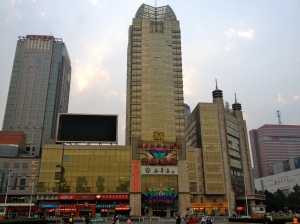
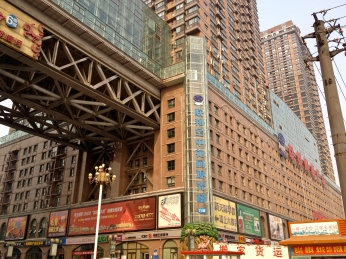


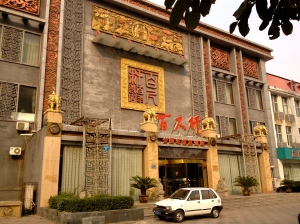

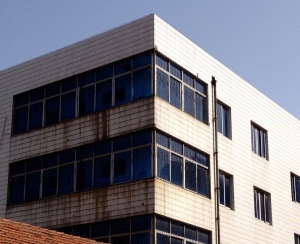

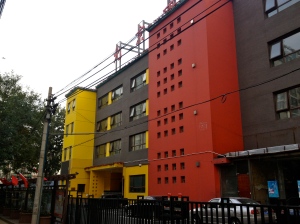
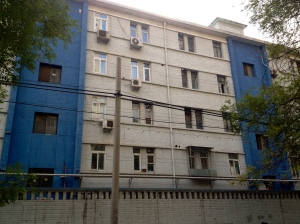

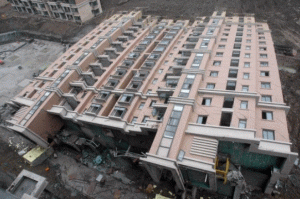












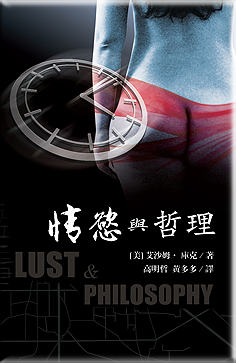

Great read, thanks very much.
In terms of the construction in China, this has always been quite a fascinating subject to me. When I first arrived in Shanghai in 2001, the entire city was like one big building site. It was quite rough living here back then as everything seemed to be covered in dust and half built or half knocked down.
There were vast areas of those old six-storey houses everywhere and to be honest I miss seeing that. As with everything in China, the newness looks great from the outside, but as you clearly point out, this is all just a veneer.
A friend of mine has similar feelings and he has a habit of pointing out new high-rises that have the paint falling off or corrosion stains seeping down the sides of the walls. All of this crappy looking stuff could be dealt with from the beginning by spending money properly instead of trying to cut corners or steal money.
Years ago, Songjiang district to the south of Shanghai was the countryside. Now it is infested with rows and rows and rows of tower blocks, all identical and with no heart to any of it. When I say heart, I mean there is no centre to anything, but also of course, no soul. There are just the usual mini-centres with a Lianhua supermarket and a convenience store. Who the fuck in their right mind would live there?
On a social level, life in China is getting worse, so imagine the kind of place these will be when crime starts escalating.
And of course the business model of China is to keep on building. They have to do that. Something like 40% of their precious GDP relies on it. As one of my students said to me (a smart guy actually): What kind of business model is that?
I live in Xujiahui, probably the most southern point of the Shanghai ‘downtown’ area. Turn left and I’m definitely downtown, turn right and I’m talking to waidi ren and farmers. But I am ten minutes away from three large shopping malls that all have the same Gap/Uniqlo/Starbucks crap in all of them. Three. It’s insane.
Everyone makes the same Bladerunner/Neuromancer analogies (oops, so did I), but all we need is the massive scale of urban crime (which I think will inevitably come) and it will be just that.
Yes, it’s well known by sociologists that concentrating populations in high-rise housing blocks without investing in community infrastructure (parks, recreation and sports facilities, libraries, markets) breeds crime. It’s basically tenement housing on the biggest scale ever seen before.
Le Corbusier thought it would work. Just shows you can never trust the French.
I know this sounds harsh, but it’s fascinating to watch this train wreck called Chinese society.
Reblogged this on Lloyd Lofthouse and commented:
Is it better to have disposable cities or disposable armies fighting one war after another as in the United States? What do I mean? I mean to say that if we are going to spend money so people have jobs, rebuilding cities may be a better choice than waging wars as the United States has done in Vietnam, Iraq and Afghanistan. While China keeps spending money rebuilding cities and keeping people working, the US keeps spending more money inventing new ways to kill people with weapons that were once only read about in science fiction novels.
Good point, Lloyd. We live in a culture of waste, which takes different forms around the world. The US is able to offload its military waste and destruction in other countries. China is also offloading its variety of waste increasingly abroad – in Africa.
David- Haven’t been to China for quite a while, as you know, but based on your perceptive and informative postings, I’m in now hurry to return. Keep up the good work and thanks!
JSR in Chicago
I meant NO hurry.